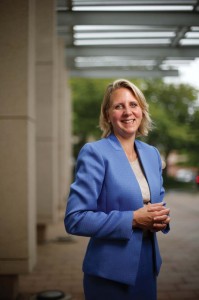Up in smoke
December 18, 2014 | Jessica Pasley

Photo by John Russell
It has been 50 years since Luther Terry, M.D., the ninth Surgeon General, released the landmark report detailing health risks of smoking. Despite smoking being the single greatest preventable cause of illnesses, disability and death in the United States, it is not considered a chronic health condition.
Hilary Tindle, M.D., MPH, aims to change that designation, or at least alter how it is treated, at Vanderbilt University Medical Center.
Her vision: automated systems to treat tobacco use.
Although this sounds simple enough, the concept was considered revolutionary in the smoking cessation field until recently, said Tindle.
“When a person comes into a clinic or a hospital with high blood pressure or diabetes, the doctor doesn’t tell that person ‘when you are ready to talk about how to lower your blood pressure or manage your diabetes, let me know and we can discuss options.’
“You treat them right then,” said Tindle. “We start patients on medications and introduce behavioral changes. The same thing needs to be done for smoking.”
This approach to smoking as a chronic condition is a tenet of national guidelines and this year’s report celebrating the 50th anniversary, to which Tindle was a contributing author: The Health Consequences of Smoking—50 Years of Progress: A Report of the Surgeon General.
Statistics show that 18 percent or nearly one in five adults in the U.S. are smokers. That group drives a sizable portion of the total disease burden including cancer, cardiovascular and pulmonary conditions.
“The burden of disability, disease and early death is almost incalculable,” Tindle stressed. “Something has to be done. Behaviors are the building blocks of health and disease, and they need attention.
“Smoking is a chronic condition, an addiction that needs proper treatment over time. Developing better ways to control smoking and tobacco use is a chance to make a broad impact on public health.
“I want to build programs that automatically trigger a referral for an identified tobacco user to get treated,” she said.
Treatment consists of a combination of professional counseling and FDA-approved medications such as the nicotine patch or gum.
The concept, although novel to many, is not new to Tindle. She created a similar system at the University of Pittsburgh in Pennsylvania in 2011 called the Tobacco Treatment Service (TTS).
From May 1, 2013, through May 14, 2014, the TTS screened 5,020 hospitalized smokers, and counseled 65 percent of those patients. More than 40 percent of counseled patients received stop-smoking medication during hospitalization. The program saw a hospital-wide rollout in March 2013.
Since arriving at Vanderbilt in July, Tindle has been working to develop an electronic referral system that automatically connects patients to the Tennessee quit line (1-800-QUIT-NOW) for smoking cessation, which is part of a national network that provides free counseling over a one-year period. Smokers get support to set a quit date, identify smoking triggers, and build skills necessary to remain smoke free long term.
“Relatively few people know about the help line and even fewer people actually use it,” Tindle said, referring to the fact that less than 1 percent of smokers call to access the service. “We need a huge education campaign for providers, patients and really the entire health care system. This is a completely different method of addressing smoking cessation.”
According to Tindle, if 2 million people were connected to the quit lines each year and 25 percent quit smoking (based on national estimates) this would translate into 500,000 fewer smokers a year, about 13,500 fewer cardiovascular disease events and 29,500 fewer deaths over the next three years.
Even before a patient calls the quit line, help is available in the clinic and at the bedside.
In as little as 3 minutes, health care providers can perform what is called a “brief intervention” to talk about the importance of quitting smoking, delivering a clear message through the five A’s: Ask about medicine; Advise quitting now; Assess readiness to quit; Assist through counseling and medications; Arrange for follow-up.
In 1964, well over 40 percent of the nation smoked. Today, that figure is about 18 percent, but the reduction has not been equal nationwide, Tindle said. There are areas, especially in the South, where 25 to 30 percent or more still smoke.
“Percentage-wise we are doing great because we have cut the number in half, but still there are 40 million smokers today.” said Tindle. “Half of them, 20 million people, are going to an early grave from smoking-related diseases. It is unequivocal. Tobacco literally takes years of valuable life from this population—quality of life.”
